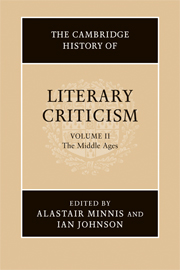Book contents
- Frontmatter
- Introduction
- I THE LIBERAL ARTS AND THE ARTS OF LATIN TEXTUALITY
- II THE STUDY OF CLASSICAL AUTHORS
- III TEXTUAL PSYCHOLOGIES: IMAGINATION, MEMORY, PLEASURE
- IV VERNACULAR CRITICAL TRADITIONS: THE EARLY MIDDLE AGES
- 9 Medieval Irish literary theory and criticism
- 10 Anglo-Saxon textual attitudes
- 11 Literary theory and practice in early-medieval Germany
- 12 Literary criticism in Welsh before c. 1300
- 13 Criticism and literary theory in Old Norse-Icelandic
- V VERNACULAR CRITICAL TRADITIONS: THE LATE MIDDLE AGES
- VI LATIN AND VERNACULAR IN ITALIAN LITERARY THEORY
- VII BYZANTINE LITERARY THEORY AND CRITICISM
- Bibliography
- Index
- References
9 - Medieval Irish literary theory and criticism
from IV - VERNACULAR CRITICAL TRADITIONS: THE EARLY MIDDLE AGES
Published online by Cambridge University Press: 28 March 2008
- Frontmatter
- Introduction
- I THE LIBERAL ARTS AND THE ARTS OF LATIN TEXTUALITY
- II THE STUDY OF CLASSICAL AUTHORS
- III TEXTUAL PSYCHOLOGIES: IMAGINATION, MEMORY, PLEASURE
- IV VERNACULAR CRITICAL TRADITIONS: THE EARLY MIDDLE AGES
- 9 Medieval Irish literary theory and criticism
- 10 Anglo-Saxon textual attitudes
- 11 Literary theory and practice in early-medieval Germany
- 12 Literary criticism in Welsh before c. 1300
- 13 Criticism and literary theory in Old Norse-Icelandic
- V VERNACULAR CRITICAL TRADITIONS: THE LATE MIDDLE AGES
- VI LATIN AND VERNACULAR IN ITALIAN LITERARY THEORY
- VII BYZANTINE LITERARY THEORY AND CRITICISM
- Bibliography
- Index
- References
Summary
Poetic theory
Medieval Irish vernacular poetics were hierarchical, reflecting a prescriptive and idealised vision of Irish society. The various metres and poetic forms were held to correspond to the status and functions of various types of poets (filid and baird) and their appropriate patrons. Poetry with a social function – praise and satire – was of paramount importance, at the expense of the now much-anthologised informal lyrics. This emphasis no doubt reflects some degree of institutional continuity from the ancient Celtic world, for the old Celtic term for poet, bardos, pl. bardi, survived in Old Irish as bard, baird (and in Welsh as bardd, beirdd). Three Celtic learned classes held in exceptional honour were generally noted by the classical writers: bards who were singers and poets, given to singing praise and satire to the accompaniment of lyre-like instruments, vates (oυατεις) or diviners (μαντεις), and druids. These correspond to Old Irish bard ‘poet (of a lower grade)’, fáith ‘prophet (pagan or biblical)’, and druí ‘druid’, although the fact that the Irish terms occur alongside a plethora of other terms and not as a discrete triad discourages speculation about the possible survival of a tripartite system.
The Old Irish laws, which were mostly written in the seventh and eighth centuries, give us a generalised and probably rather idealised picture of early Irish society, as seen by the writers of the laws, who were either professional lawyers or legally minded churchmen (or both). The laws are obsessed with rank and status and are careful to specify the exact rank of poets and other professional persons in a hierarchy ranging from the ‘free/noble’ (sóer) down to the ‘unfree/base’ (dóer).
- Type
- Chapter
- Information
- The Cambridge History of Literary Criticism , pp. 289 - 309Publisher: Cambridge University PressPrint publication year: 2005



